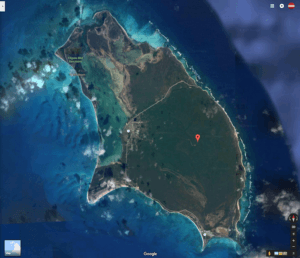Frigatebird Sanctuary, Barbuda
Posted by David Porter on Saturday, December 17, 2016 · Leave a Comment
 Visiting the Frigatebird Sanctuary on the Caribbean Island of Barbuda
Visiting the Frigatebird Sanctuary on the Caribbean Island of Barbuda
One of the great benefits of our Windstar Cruises motor sailing yacht cruise is that because of the ship’s smaller size, we were able to come in close contact with sights that the mega-ships have no chance of visiting.
For me, this is far more exciting than walking in crowds of thousands at the major ports all pushing to buy a t-shirt.
As we approached the Caribbean Island of Barbuda, we were the only ocean vessel in sight. There were perhaps 30 of us who decided to make the morning journey to the island’s famous frigatebird sanctuary, while others were perhaps off in search of the island’s pink sand beaches, or perhaps to explore the island’s unique caves.
Barbuda is the sister island of Antigua and is located 28 miles to the north. The island is flat with the highest point being only 125 feet. When I gazed upon the island from our ship, I wondered how the islanders might fare during a hurricane with no high ground to take shelter.
 Barbuda is only 62 square miles, or 14 miles by 8 miles in size with a population of only 1500 people.
Barbuda is only 62 square miles, or 14 miles by 8 miles in size with a population of only 1500 people.
Our group of explorers boarded the ship’s tender and made our way to a very small dock perhaps an eighth of a mile from where our ship was moored.
At the dock we found islanders who boarded us into vans which whisked us across bumpy sand roads, through the small capitol village of Codrington (the only village on the island), and to another dock where small skiffs were to take us to the frigatebird sanctuary.
Our very friendly driver spoke perfect English as Barbuda was formerly under the rule of Great Britain. However, in 1981, the islands of Antigua and Barbuda became an independent state within the Commonwealth of Nations.
As we made our way to our launching point, I couldn’t help but think of the horrors that our driver’s ancestors must have faced as Codrington in the 1700s was a nursery for slaves who were forced to work in the sugarcane plantations. It’s quite horrible to consider!
Anyway, we hopped into small skiffs and made our roughly 15-minute journey to the frigatebird sanctuary. Here’s a few of my photographs from the sanctuary:





As you can see in my photographs, the male frigatebirds possess bright red gular pouches which they inflate during the mating season to attract the females, while the females have white underbellies. The frigatebird has a wingspan that reaches up to 7.5 feet and our guide told us that they can glide up to 30-days on wind currents.
Frigatebirds will spend most of their day in flight hunting for food. Their main prey are fish and squid that are chased to the water’s surface by large predators such as tuna. Our guide also shared with us that the frigatebird does not like to be in the water and will actually drown if they were to find themselves in the water.
By the way, the bird in the last slide is a brown boobie. He must like hanging with the frigatebirds.
I greatly enjoyed our visit to the frigatebird sanctuary. It made me feel a bit like Marlin Perkins on the television show Mutual of Omaha’s Wild Kingdom. Remember that?
If you’re considering a visit to the Caribbean’s West Indies, we highly recommend that you consider a visit to Barbuda’s frigatebird sanctuary. And further, we highly recommend that you visit the islands aboard a motor sailing yacht like the Windstar Cruises Windsurf. It’s an experience that we look forward to repeating in another scenic spot in the world.
To explore other articles about our sailing experience with Windstar Cruises, click here.
Disclosure: our experience was provided by the kind folks at Windstar Cruises. Thanks!
If you enjoyed this article, sign up for our travel newsletter to keep abreast of our best travel tips, on-location reviews, exclusive travel offers, group travel events, and much more.

Category: Barbuda, Blog, Caribbean Cruises, Windstar Cruises · Tags: Barbuda, Caribbean Cruises, Caribbean Islands, Windstar Cruises
 The Roaming Boomers
The Roaming Boomers



